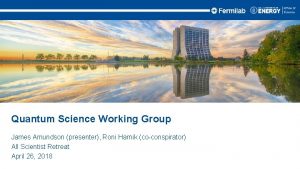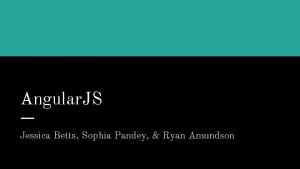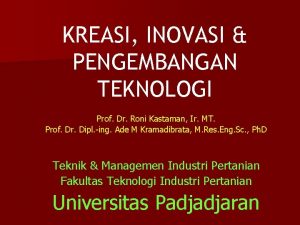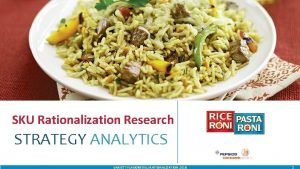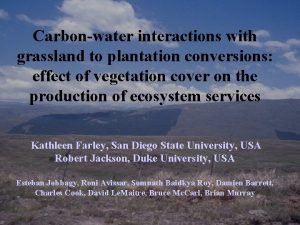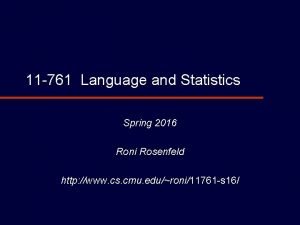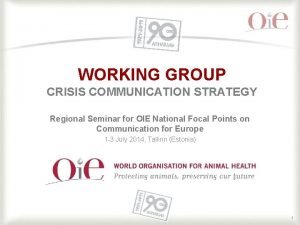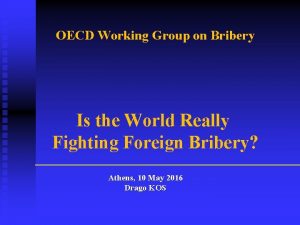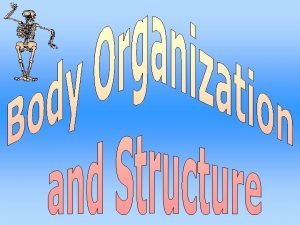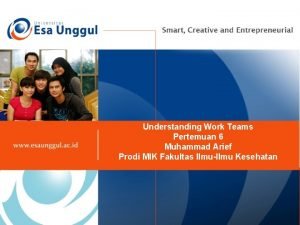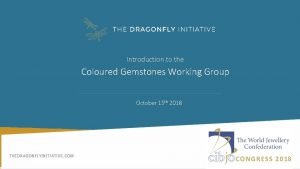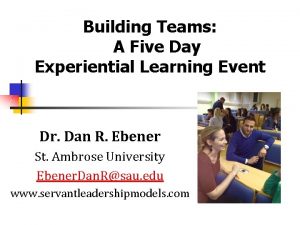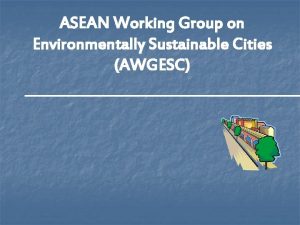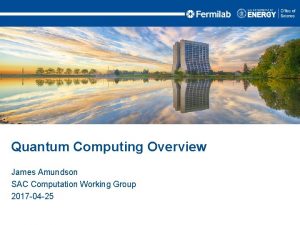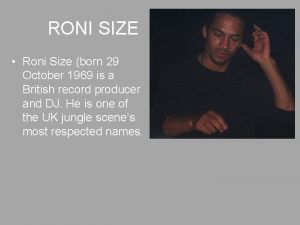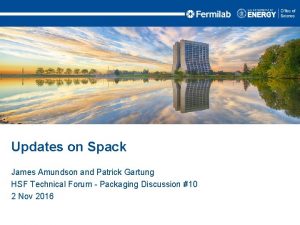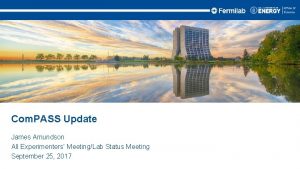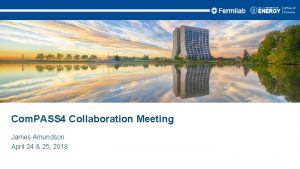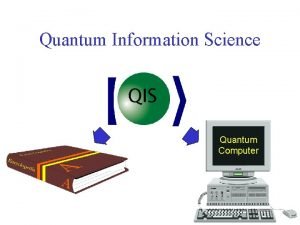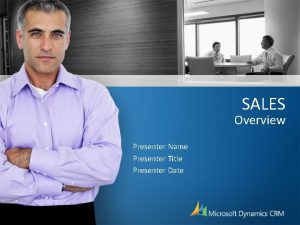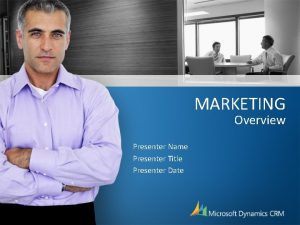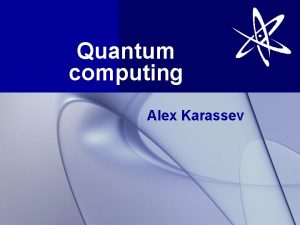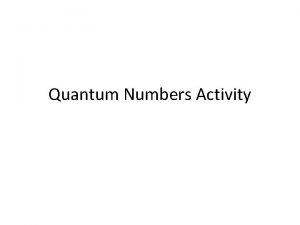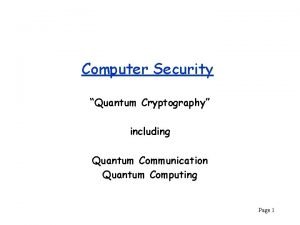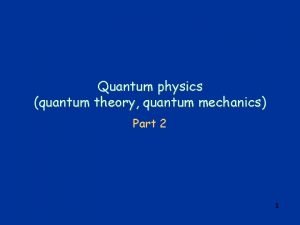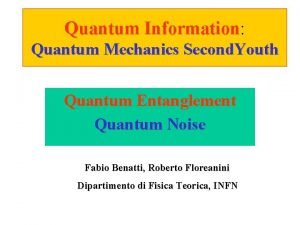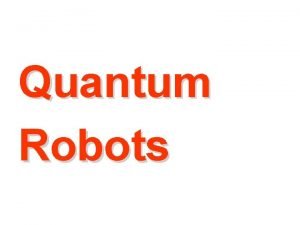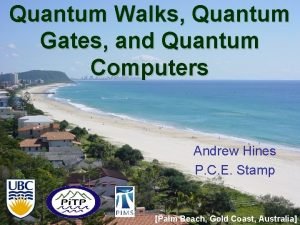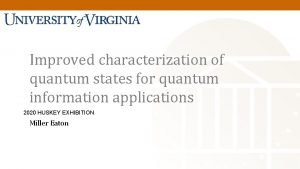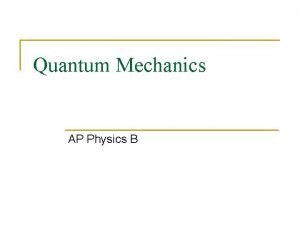Quantum Science Working Group James Amundson presenter Roni

























- Slides: 25

Quantum Science Working Group James Amundson (presenter), Roni Harnik (co-conspirator) All Scientist Retreat April 26, 2018

The Future of Quantum Computing The prospects for Quantum Computing in 2026: 2 4/26/18 Amundson | Quantum Science Working Group

The Future of Quantum Computing ? ? ? 3 4/26/18 Amundson | Quantum Science Working Group

Quantum Science Working Group This working group is not like the others • Quantum Information Science (QIS) efforts are relatively new in HEP and at the Lab – “new” can mean the past few years or the past few months • QIS is a young and rapidly changing field • Many groups at the lab recently submitted proposals to the first explicit QIS for HEP funding opportunity – Short time between announcement and deadline lead to intensive work during the working group period – I will summarize list the proposals here • including a few highlights 4 4/26/18 Amundson | Quantum Science Working Group

Why the Excitement? (In One Slide) • Classical: storable information scales linearly in the number of bits • Quantum: storable information scales exponentially in the number of qubits • There are known quantum algorithms with exponential speedup – Early example: factoring large numbers • 5 4/26/18 Amundson | Quantum Science Working Group Taken from LA-UR-97 -4986 “Cryptography, Quantum Computation and Trapped Ions, Richard J. Hughes (1997)

Recent Funding Announcement Quantum Information Science Enabled Discovery (Quant. ISED) For High Energy Physics Topic A: High Energy Physics and QIS Research – (i) Theoretical, Computational, and/or experimental research exploiting recent convergence of developments in quantum gravity, computational complexity, Ad. S/CFT holographic correspondence, quantum information theory, emergence of space-time, quantum error correction, black hole physics, scrambling, and qubit system thermalization; – (ii) Foundational field theory techniques, gauge symmetries, and tensor networks invoking quantum information and entanglement concepts that advance knowledge including description of scattering, bound state problems, and advanced gauge theories; – (iii) Analog simulations/quantum emulators/teleportation experiments that advance HEP and QIS, including tests of fundamental string theory and other particle physics models in qubit systems; – (iv) Novel experiments probing HEP science drivers using QIS technology and tools exploiting superposition, entanglement, and/or squeezing with goals for near term science goals and/or steps to scientific discovery – (v) HEP relevant instrumentation, data transfer and quantum communication tools using QIS concepts and QIS technology exploiting superposition, entanglement, and/or squeezing that produce new experimental methods for HEP; – (vi) Foundational and/or technological advances in QIS by incorporation of techniques, tools, and physical principles from particle physics 6 4/26/18 Amundson | Quantum Science Working Group

Recent Funding Announcement, continued • Topic B: Quantum Computing for HEP on current or future quantum computing systems – (i) Quantum field theory algorithms and simulations including quantum chromodynamics and electrodynamics, accelerator modeling codes, and computational cosmology relevant to HEP science drivers and P 5 projects and experiments; – (ii) Quantum machine learning and data analysis techniques and tools that can enhance efficiency or analysis methods for HEP applications. Applications using available annealer platforms are within scope and so are use of quantum computers simulated classically; – (iii) Developing quantum computing simulators and/or frameworks for HEP applications to be developed on existing computers or hybrid systems. 7 4/26/18 Amundson | Quantum Science Working Group

Proposed Fermilab QIS Work • Includes Fermilab-led proposals as well as proposals in which Fermilab is participating, but not leading. 8 4/26/18 Amundson | Quantum Science Working Group

Ultra-High Q Superconducting Accelerator Cavities for Orders of Magnitude Improvement in Qubit Coherence Times and Dark Sector Searches • Topic A (vi): High Energy Physics and QIS Research (Foundational and/or technological advances in QIS by incorporation of techniques, tools, and physical principles from particle physics) • Lead Principal Investigator: Dr. Alexander Romanenko – Other Senior Personnel: Dr. Anna Grassellino, Dr. Roni Harnik, Dr. Mohamed Hassan • Participating institution #1: University of Wisconsin, Madison – Co-Principal Investigator: Prof. Robert Mc. Dermott • Participating institution #2: National Institute of Standards and Technology (NIST) – Co-Principal Investigator: Dr. David Pappas 9 4/26/18 Amundson | Quantum Science Working Group

SRF technology to enable high coherence qubits SRF resonators Qubit lifetime 10 4/26/18 > 1 s 1 - 1000 μs 1 - 100 ns SRF technology Transmon 3 D architecture H. Paik et al. , Phys. Rev. Lett. (2011) Cooper-pair box Y. Nakamura et al. , Nature (1999) Amundson | Quantum Science Working Group

Novel Cold Instrumentation Electronics for Quantum Information Systems • Topic A (vi): High Energy Physics and QIS Research (Foundational and/or technological advances in QIS by incorporation of techniques, tools, and physical principles from particle physics). • Lead Principal Investigator: Dr. Davide Braga • Senior Investigator: Dr. Gregory Deptuch • Key Personnel: Dr. Sandeep Miryala, Dr. Pamela Klabbers, Dr. Matthew Hollister • Participating Institution: Georgia Institute of Technology – Co-Principal Investigator: Prof. John D. Cressler – Senior Investigator: Prof. Dragomir Davidovic 11 4/26/18 Amundson | Quantum Science Working Group

Matter-wave Atomic Gradiometer Interferometric Sensor (MAGIS-100) • Topic A (iv) and (vi): High Energy Physics and QIS Research. • Lead PI: Robert Plunkett – Other Senior Personnel: Phil Adamson, Steve Geer, Roni Harnik • Participating Institution: Stanford – Co-PI: Jason Hogan – Other Senior Personnel: Peter Graham, Mark Kasevich • Participating Institution: Northern Illinois University – Co-PI: Swapan Chattopadhyay • Participating Institution: University of California at Berkeley – Co-Pi: Surjeet Rajendran • Additional Senior Co-Investigators: Jonathon Coleman (Univ. of Liverpool, UK) • Critical supporting scientific and technical personnel: – Steve Hahn (FNAL), Jeremiah Mitchell (NIU), Linda Valerio (FNAL), Arvydas Vasonis (FNAL) 12 4/26/18 Amundson | Quantum Science Working Group

Matter wave interferometry at large scales MAGIS-100 Sensor concept Atoms in free fall 50 meters Atom Source 2 50 meters Quantum superposition 100 meters Probed using common laser pulses Atom Source 1 Matter wave interference pattern readout Atom Source 3 Laser pulse (red) Model of top of existing shaft, showing laser emplacement. A large macroscopic quantum instrument Atom matter waves in superposition separated by up to 10 meters, durations up to 9 seconds CAD model of detector in Free-falling ultra-cold atoms in MINOS Shaft, in shielded beam 100 -meter MINOS shaft ) pipe. 13 4/26/18 Amundson | Quantum Science Working Group

Light Pulse Atom Interferometry Increase acceleration sensitivity: Long duration 10 meter scale atomic fountain 14 4/26/18 Amundson | Quantum Science Working Group Large wavepacket separation

Skipper-CCD: new single photon sensor for quantum imaging • Topic A (vi): High Energy Physics and QIS Research (Foundational and/or technological advances in QIS by incorporation of techniques, tools, and physical principles from particle physics) • Lead PI: Juan Estrada (Fermilab) • Co-PI: Steve Holland (LBL) • Senior/Key Personnel: Cristian Pena (Fermilab), Roni Harnik (Fermilab), Javier Tiffenberg (Fermilab), Neil Sinclair (Caltech), Si Xie (Caltech), Carlos Escobar (Fermilab) 15 4/26/18 Amundson | Quantum Science Working Group

skipper-CCD for quantum imaging state-of-the-art sensors can not count more than 1 photon (EMCCD) 16 4/26/18 Amundson | Quantum Science Working Group entangled photons produced with non-linear crystal and imaged with CCDs. [sub-shot noise imaging] skipper-CCD developed by FNAL+LBNL can count whatever number you like…

A) demonstrate existing skipper in quantum imaging done a few years ago with DECam CCDs (D. Kubik) and by C. Escobar with single pixels. 17 4/26/18 B) investigate the possibility of entangled dark photon production experiment (Roni’s idea) C) optimize skipper-CCD for quantum imaging experiments (lower dynamic range and higher readout speed). S. Holland from LBNL Amundson | Quantum Science Working Group

Quantum Metrology Techniques for Axion Dark Matter Detection • Topic A (v): High Energy Physics and QIS Research, HEP relevant instrumentation using QIS technology • Lead Principal Investigator: Aaron Chou – Additional Senior Personnel: Daniel Bowring • Participating institution #1: The University of Chicago – Co-Principal Investigator: Prof. David Schuster • Participating institution #2: JILA/University of Colorado/NIST – Co-Principal Investigator: Prof. Konrad Lehnert • Participating institution #3: Yale University – Co-Principal Investigator: Prof. Reina Maruyama 18 4/26/18 Amundson | Quantum Science Working Group

Use qubits as single photon buckets to load the cavity into a Fock state of definite photon number (no Poisson noise), and maximally indefinite phase. This is a Schrodinger’s cat state of the cavity mode in a symmetric quantum superposition of all possible oscillation phases. Get stimulated enhancement of signal Prepare cavity in vacuum state: Prepare cavity in N=10 Fock state: Harmonic oscillator phase space Antiphase Dark matter gives small displacement from origin. This spontaneous emission gives tiny population of N=1 state. 119 4/26/18 Amundson | Quantum Science Working Group Inphase Displacement by dark matter causes stimulated emission and stimulated absorption rates enhanced by factor 10!

Quantum Communication Channels for Fundamental Physics (QCCFP) • Topic A: High Energy Physics and QIS Research, Subtopics A(i), A(iii) • Sponsoring (lead) institution: California Institute of Technology – Lead Principal Investigator: Maria Spiropulu • Participating consortium institution: Fermilab – Co-Principal Investigator: Cristian Pen a • Participating consortium institution: MIT – Co-Principal Investigator: Daniel Harlow • Participating consortium institution: Harvard – Co-Principal Investigator: Daniel L. Jafferis • Senior/Key Personnel: • Joseph Lykken, Fermilab, Kathryn Zurek, LBNL, Fernando Brandao, Caltech, Thomas Vidick, Hirosi Ooguri, Caltech, Si Xie, Caltech, Neil Sinclair, Caltech 20 4/26/18 Amundson | Quantum Science Working Group

Framework and Interfaces for Hybrid Classical-Quantum Systems • Topic B (iii) Developing quantum computing simulators and/or frameworks for HEP applications to be developed on existing computers or hybrid systems. • Lead PI: Dr. Adam L. Lyon • Senior/Key Personnel: Burt Holzman, James Kowalkowski, Panagiotis Spentzouris 21 4/26/18 Amundson | Quantum Science Working Group

Quantum Machine Learning and Quantum Computation Frameworks for HEP (QMLQCF) • Topic B: Quantum Computing for HEP, Subtopics B(ii), B(iii) • Sponsoring (lead) institution: California Institute of Technology • Lead Principal Investigator: Maria Spiropulu – Caltech Co-Principal Investigator: Jean-Roch Vlimant • Participating institution: USC – Co-Principal Investigator: Daniel Lidar • Participating institution: Fermilab – Co-Principal Investigator: Panagiotis Spentzouris • Participating institution: MIT – Co-Principal Investigator: Seth Lloyd, 617 -253 -1803, slloyd@mit. edu • Senior/Key Personnel: – Joshua Job, USC, Alex Mott, Deep. Mind 22 4/26/18 Amundson | Quantum Science Working Group

HEP ML and Optimization Go Quantum • Topic B (ii) Quantum machine learning and data analysis techniques and tools that can enhance efficiency or analysis methods for HEP applications. • Lead PI: Gabriel Perdue • Participating Institution: Oak Ridge National Laboratory (ORNL) – Co-Principal Investigator: Travis Humble • Senior/Key Personnel: James Kowalkowski (FNAL), Alex Mc. Caskey (ORNL), Stephen Mrenna (FNAL), Brian Nord (FNAL) 23 4/26/18 Amundson | Quantum Science Working Group

Quantum Information Science for Applied Quantum Field Theory • Topic A (ii): Foundational field theory techniques, gauge symmetries, and tensor networks invoking quantum information and entanglement concepts that advance knowledge including description of scattering, bound state problems, and advanced gauge theories. • Lead Principal Investigator: Marcela Carena • Participating Institution #1: California Institute of Technology – Co-Principal Investigator: John Preskill • Participating Institution #2: University of Washington – Co-Principal Investigators: David Kaplan and Martin Savage • Senior/Key Personnel: • James Amundson, Dan Carney, Walter Giele, Roni Harnik, Kiel Howe, Ciaran Hughes, Joshua Isaacson, Andreas Kronfeld, Alexandru Macridin, Stefan Prestel, James Simone, Panagiotis Spentzouris 24 4/26/18 Amundson | Quantum Science Working Group

Proposed Fermilab QIS Work Summary • Four main themes – Use HEP technology to advance quantum technology • Superconducting RF, cold electronics, data acquisition, etc. – Use quantum technology to build more sensitive detectors • High-precision measurements, dark matter searches, axion searches, gravitational wave detection, etc. – Explore the possibilities of quantum networking – Explore applications of quantum computing to HEP topics • Machine learning, optimization • Simulation of quantum processes Quantum Information Science is a rapidly developing field. The work described here is a snapshot of the initial Fermilab efforts to both advance and take advantage of advances in QIS. 25 4/26/18 Amundson | Quantum Science Working Group
 James amundson
James amundson Kariyer tekeri modeli
Kariyer tekeri modeli Ryan pandey
Ryan pandey Bo jalais background
Bo jalais background Roni kastaman
Roni kastaman Rice a roni flavors ranked
Rice a roni flavors ranked Roni avissar
Roni avissar Roni rosenfeld
Roni rosenfeld Quantum physics vs quantum mechanics
Quantum physics vs quantum mechanics Quantum physics vs mechanics
Quantum physics vs mechanics Smart work vs hard work
Smart work vs hard work Hot working and cold working
Hot working and cold working Hot working and cold working difference
Hot working and cold working difference Differentiate between hot working and cold working
Differentiate between hot working and cold working Pembentukan plat pada pengerjaan panas
Pembentukan plat pada pengerjaan panas My favourite subject is pe
My favourite subject is pe Russell odom and clay lawson
Russell odom and clay lawson James russell odom
James russell odom Crisis communications working group
Crisis communications working group Oecd working group on bribery
Oecd working group on bribery Similar cells working together
Similar cells working together Turning individuals into team players
Turning individuals into team players Coloured gemstones working group archives
Coloured gemstones working group archives Team vs working group
Team vs working group Awgesc asean
Awgesc asean Awgcc
Awgcc
